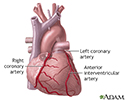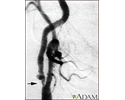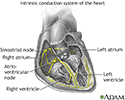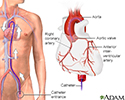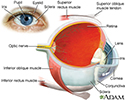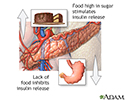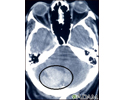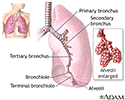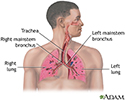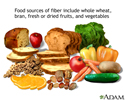Multimedia Gallery
Varicose veins
From the outside, your veins look like nothing more than a few faint blue lines under your skin. But inside your body, they work hard to transport blood from your organs to your heart. Sometimes, blood can get stuck in your veins and make them swell up so they really stick out. These swollen veins are called varicose veins. And if you have them, you may be putting a lot of effort into covering them up.
Veins have valves in them that prevent blood from flowing the wrong way. They're kind of like the valves in your bathroom plumbing that prevent hot water in the water heater from backing up into the cold water supply. The valves inside your veins make sure that your blood keeps flowing in the right direction, toward your heart. But if those valves aren't working correctly, blood can back up and get stuck inside a vein. As the blood collects, the vein swells.
So, what causes the valves in the veins to malfunction? Well, you may have been born with defective valves. Or, you might be putting on extra pressure on the veins in your legs if you stand for long periods of time, or you're pregnant.
When you have varicose veins, you, and your doctor, should be able to tell just by looking at them. They look like raised, thick blue or purple veins. Varicose veins can also make your legs ache and your ankles swell.
So, how are varicose veins treated?
Well, first, your doctor will recommend rest and support for your varicose veins. Avoid standing for long periods of time, and prop up your feet on a pillow or box whenever you sit. Wearing elastic support hose can also help.
If you're in a lot of pain from your varicose veins, or their appearance really bothers you, your doctor may recommend a treatment such as lasers to minimize the veins. Or, you may have a type of surgery called vein stripping. During this procedure, the surgeon threads a thin, plastic wire into each varicose vein and then pulls the vein out.
At first, varicose veins are more of a cosmetic problem than a health issue. But over time, they can get worse. Some people develop sores, inflammation from phlebitis, clots, or their varicose vein breaks. Talk to your doctor if you have varicose veins, especially if they hurt or they don't improve from wearing support hose or staying off your feet. Call your doctor right away if you have intense pain, swelling, fever, or a sore on your leg.
Varicose veins
Review Date: 1/29/2025
Reviewed By: Deepak Sudheendra, MD, MHCI, RPVI, FSIR, CEO & Medical Director, 360 Vascular Institute, with an expertise in Vascular Interventional Radiology & Surgical Critical Care, Columbus, OH. Review provided by VeriMed Healthcare Network. Also reviewed by David C. Dugdale, MD, Medical Director, Brenda Conaway, Editorial Director, and the A.D.A.M. Editorial team.
Animations
- Abdominal aortic aneurysm
- Abdominal pain
- Aneurysm description
- Arrhythmias
- Atherosclerosis
- Atrial fibrillation
- Balloon angioplasty - short...
- Blood clotting
- Blood flow
- Blood pressure
- Brain components
- Cardiac and vascular disord...
- Cardiac arrhythmia - conduc...
- Cardiac arrhythmia symptoms
- Cardiac arrhythmia tests: E...
- Cardiac arrhythmia: Additio...
- Cardiac arrhythmia: Heart p...
- Cardiac arrhythmia: Physica...
- Cardiac arrhythmia: Taking ...
- Cardiac catheterization
- Cardiac catheterization - a...
- Cardiac conduction system
- Cardiac CT scan overview
- Cardiomyopathy
- Cardiovascular system
- Causes and side effects of ...
- Cerebral aneurysm
- Chest pain
- Childhood obesity
- Cholesterol and triglycerid...
- Coronary artery bypass graf...
- Coronary artery disease
- Coronary artery disease (CA...
- Directional coronary athere...
- Electrocardiogram
- Epinephrine and exercise
- Erection problems
- Essential hypertension
- Exercise
- Hardening of arteries
- Healthy Guide to Fast Food
- Heart attack
- Heart bypass surgery
- Heart failure
- Heart formation
- Heartbeat
- How to use a pill cutter
- Hypertension
- Hypertension - overview
- Muscle types
- NICU consultants and suppor...
- Nuclear stress test
- Obstructive sleep apnea
- Percutaneous transluminal c...
- Preeclampsia
- Smoking
- Smoking tips to quit
- Snoring
- Stent
- Stroke
- Stroke
- Stroke - secondary to cardi...
- Tachycardia
- Tobacco use - effects on ar...
- Tracking your blood pressur...
- Type 2 diabetes
- Understanding cholesterol r...
- Vacation health care
- Valvular heart disease (VHD...
- Varicose veins
- Varicose veins overview
- Venous insufficiency
- What makes your heart beat?
Illustrations
- 15/15 rule
- Absent pulmonary valve
- Acute MI
- Adjustable gastric banding
- Aerobic exercise
- Alcoholic cardiomyopathy
- Alpha-glucosidase inhibitors
- Angina
- Anomalous left coronary artery
- Anterior heart arteries
- Aortic aneurysm
- Aortic dissection
- Aortic rupture - chest x-ray
- Aortic stenosis
- Aortopulmonary window
- Arterial embolism
- Arterial plaque build-up
- Arterial tear in internal c...
- Arteries of the brain
- Artery cut section
- Atherosclerosis
- Atherosclerosis of internal...
- Atherosclerosis of the extr...
- Atrial septal defect
- Atrioventricular block - EC...
- Atrioventricular canal (end...
- Auscultation
- Bacterial pericarditis
- Balance receptors
- Bicuspid aortic valve
- Biguanides
- Biliopancreatic diversion (BPD)
- Biliopancreatic diversion w...
- Biopsy catheter
- Blood pressure
- Blood pressure check
- Blood test
- Bradycardia
- Brain
- Brainstem function
- Breathing
- Bronchial cancer - CT scan
- Calcium benefit
- Calcium source
- Calories and fat per serving
- Cardiac arteriogram
- Cardiac catheterization
- Cardiac catheterization
- Carotid dissection
- Carotid duplex
- Carotid stenosis - X-ray of...
- Carotid stenosis - X-ray of...
- Cataract
- Cataract - close-up of the eye
- Central nervous system and ...
- Cerebellum - function
- Cerebral aneurysm
- Cholesterol
- Cholesterol producers
- Circle of Willis
- Circulation of blood throug...
- Circulatory system
- Clubbing
- Coarctation of the aorta
- Conduction system of the heart
- Constrictive pericarditis
- Coronary angiography
- Coronary artery blockage
- Coronary artery disease
- Coronary artery disease
- Coronary artery fistula
- Coronary artery spasm
- Coronary artery stent
- Crossed eyes
- CT scan
- Culture-negative endocarditis
- Cyanosis of the nail bed
- Cyanotic heart disease
- DASH diet
- Deep veins
- Deep veins
- Deep venous thrombosis - il...
- Developmental process of at...
- Dextrocardia
- Diabetes and exercise
- Diabetic emergency supplies
- Digestive system
- Dilated cardiomyopathy
- Double aortic arch
- Double inlet left ventricle
- Double outlet right ventricle
- Drug induced hypertension
- Duplex/doppler ultrasound test
- Ear anatomy
- Ebstein's anomaly
- ECG
- ECMO
- Effects of age on blood pressure
- Eisenmenger syndrome (or co...
- Electrocardiogram (ECG)
- Emphysema
- Endarterectomy
- Endocrine glands
- Enlarged view of atherosclerosis
- Exercise - a powerful tool
- Exercise 30 minutes a day
- Exercise can lower blood pr...
- Exercise with friends
- Eye
- Facial drooping
- Fast food
- Fish in diet
- Food and insulin release
- Food label guide for candy
- Food label guide for whole ...
- Foot swelling
- Fruits and vegetables
- Glucose in blood
- Glucose test
- Healthy diet
- Healthy diet
- Heart - front view
- Heart - section through the...
- Heart attack symptoms
- Heart beat
- Heart chambers
- Heart valves
- Heart valves - anterior view
- Heart valves - superior view
- High blood pressure tests
- Holter heart monitor
- Hypertension
- Hypertensive kidney
- Hypertrophic cardiomyopathy
- Infective endocarditis
- Insulin pump
- Insulin pump
- Intracerebellar hemorrhage ...
- Intracerebral hemorrhage
- Janeway lesion on the finger
- Jaw pain and heart attacks
- Left atrial myxoma
- Left cerebral hemisphere - ...
- Left heart catheterization
- Leg pain (Osgood-Schlatter)
- Lifestyle changes
- Lobes of the brain
- Low blood sugar symptoms
- Low nasal bridge
- Lower leg edema
- Lower leg muscles
- Lung mass, right lung - CT scan
- Lung mass, right upper lobe...
- Lung nodule, right lower lu...
- Lung with squamous cell can...
- Lungs
- Lymph tissue in the head an...
- Male reproductive anatomy
- Mitral stenosis
- Mitral valve prolapse
- Monitoring blood pressure
- MRI scans
- MUGA test
- Muscular atrophy
- myPlate
- Neck pain
- Neck pulse
- Normal anatomy of the heart
- Normal heart anatomy (cut s...
- Normal heart rhythm
- Normal lung anatomy
- Omega-3 fatty acids
- Otoscope examination
- Pacemaker
- Pericarditis
- Pericardium
- Pericardium
- Peripartum cardiomyopathy
- Pharmacy options
- Pitting edema on the leg
- Plaque buildup in arteries
- Post myocardial infarction ...
- Posterior heart arteries
- Post-MI pericarditis
- Prevention of heart disease
- Progressive build-up of pla...
- Ptosis - drooping of the eyelid
- Pulmonary nodule, solitary ...
- Quitting smoking
- Radial pulse
- Read food labels
- Respiratory cilia
- Respiratory system
- Retrocalcaneal bursitis
- Right atrial myxoma
- Right cerebral hemisphere -...
- Roux-en-Y stomach surgery f...
- Saturated fats
- Secondhand smoke and lung cancer
- Shin splints
- Slit-lamp exam
- Smoking hazards
- Smoking hazards
- Sodium content
- Sources of fiber
- Stable angina
- Starchy foods
- Striae in the popliteal fossa
- Stroke
- Sulfonylureas drug
- Superficial thrombophlebitis
- Superficial thrombophlebitis
- Swan Ganz catheterization
- Taking your carotid pulse
- Thiazolidinediones
- Thoracic organs
- Thromboangiitis obliterans
- Thrombus
- Thyroid cancer - CT scan
- Tobacco and cancer
- Tobacco and chemicals
- Tobacco and vascular disease
- Tobacco health risks
- Totally anomalous pulmonary...
- Totally anomalous pulmonary...
- Totally anomalous pulmonary...
- Trans fatty acids
- Transient Ischemic attack (TIA)
- Tricuspid Regurgitation
- Tricuspid Regurgitation
- Type I diabetes
- Ultrasound, normal fetus - ...
- Ultrasound, ventricular sep...
- Untreated hypertension
- Varicose veins
- Vascular ring
- Venous blood clot
- Ventricular septal defect
- Ventricular tachycardia
- Vertebra, thoracic (mid back)
- Vertical banded gastroplasty
- Vertigo
- Visual acuity test
- Visual field test
- Vitamin B1 benefit
- Vitamin B1 source
- Vitamin C benefit
- Vitamin C deficit
- Vitamin C source
- Vitamin E and heart disease
- Warming up and cooling down
- Wine and health

 Bookmark
Bookmark


















































































